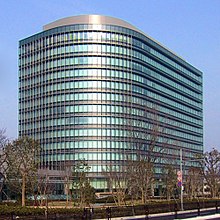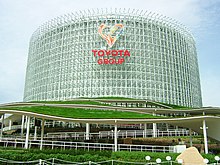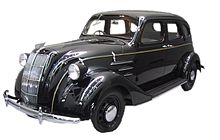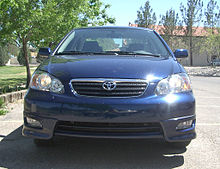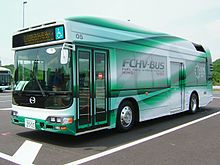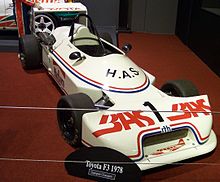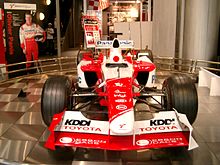Toyota
| Toyota Motor Corporation
|
|
|---|---|
| legal form | Kabushiki-gaisha (joint stock company) |
| ISIN | JP3633400001 |
| founding | August 28, 1937 |
| Seat |
Toyota , Japan |
| management |
Akio Toyoda (President) Takeshi Uchiyamada (Chairman of the Board) |
| Number of employees | 369,124 (1st quarter 2018) |
| sales | 29 trillion ¥ ( € 235 billion ) ( FY 2018) |
| Branch | Automobile manufacturing |
| Website | www.toyota-global.com |
The Toyota Motor Corporation ( Japanese トヨタ自動車株式会社 , Toyota Jidosha Kabushiki-gaisha ) is a multinational company and one of the largest automobile manufacturers in the world. In 2016, the company produced around 10.2 million vehicles, making it the world's largest carmaker in terms of production figures, ahead of Volkswagen AG (10.1 million vehicles).
Toyota is headquartered in Toyota ( Japan ) and is the 12th largest publicly traded company in the world (2018) according to the Forbes Global 2000 list. The Toyota Group with its 522 subsidiaries has a total of 369,124 employees (as of Q1 2018) and produces in addition to the 12 Japanese plants at 51 locations in 26 countries.
The company, which was founded in 1937 by Toyoda Kiichirō and Toyoda Eiji , took over the status of the world's largest automobile manufacturer before General Motors with sales of 8.972 million vehicles in 2008 , but lost this status to GM in 2011 due to several product recalls and, as a result, slightly lower sales figures . After the earthquake disaster of March 2011 , Toyota recovered quickly and was again number one in the world in the first half of 2012 with 4.97 million vehicles sold. Toyota is considered to be the "most valuable automobile brand" in the world (as of 2015).
Company data
Toyota is listed on the Nikkei 225 and at the end of 2017 had the highest market value of all automobile manufacturers. The Fortune Global 500 list of 2016 lists Toyota as the fifth largest company in the world according to its annual sales of 254.9 billion US dollars . Toyota was ranked 12th on the Forbes Global 2000 list in 2018. Toyota has now become the world's most valuable car brand and is ranked 36th worldwide with a brand value of $ 177.4 billion. In 2016, Toyota generated over $ 17 billion in profits (see also automotive industry ).
After financial setbacks, Akio Toyoda was appointed chairman in July 2009.
The Toyota Motor Corporation is headquartered in the Japanese city of Toyota (until 1959: Koromo), as well as a subsidiary in neighboring Nagoya and Bunkyō ( Tokyo ) and became an independent company in 1937. The parent company Toyota also produces many other goods such as nature reserves , prefabricated houses , boats , electronic devices and banking networks. Toyota has owned the second largest cellular network in Japan since 2005 .
Company history
Toyota's history began in a remote rural area outside Nagoya, Japan , in 1867 . It was here that Sakichi Toyoda was born that year, the son of poor carpenter Ikichi Toyoda. He learned the craft of carpenter from his father and eventually used this knowledge to design and build wooden spinning machines . In 1894 he began making manual looms , which were cheaper and worked better than previous looms. Under the impression of the difficult conditions under which his mother, grandmother and their friends had to work in the spinning and weaving mills, he began to develop power-driven wooden looms. To do this, he bought a used steam engine to conduct experiments with.
In the meantime, Sakichi's son Kiichirō Toyoda had completed a degree in mechanical engineering at Tokyo University. Together with Kiichirō, Sakichi completed his “automated loom” (Toyoda Automatic Loom) in 1924, in which a principle of the later Toyota production system was used for the first time : Jidōka , also known as autonomous automation. This loom contained a mechanism that automatically stopped the machine if a thread broke. As a result, few people were able to operate a large number of weaving machines, and a worker did not have to be assigned for every weaving machine, who only watches whether a thread breaks. For production and marketing, he founded Toyoda Automatic Loom Inc.
When Sakichi Toyoda noticed that automobiles were becoming increasingly important, he sent his son Kiichirō Toyoda to Great Britain in 1929 to sell the patent rights to his automated weaving machine to the British company Platt Brothers and to use the proceeds to build an automobile production. Kiichiro Toyoda acted 100,000 British pounds and used this capital to start building an automotive division. In 1934 the first machine was produced, which from 1935 was used to produce the first Toyota A1 and the GG truck . Start of production for the car model AA was in 1936. On August 28, 1937, Kiichirō Toyoda and his cousin Toyoda Eiji founded the Toyota Motor Corporation , into which the automobile division was incorporated. Toyo t a was chosen instead of the family name Toyoda , on the one hand to enable the founders to separate work and private life, and on the other hand to adapt the pronunciation to the simplified spelling: through the use of Katakana , the name is now written with eight strokes. The fact that the number 8 is also considered a lucky number in Japan was another important reason for the renaming. There are conflicting theories about the renaming.
During the Pacific War (1937–1945), truck production served the Japanese military . Before the planned bombing of the Toyota plants could take place, the war ended. Commercial production began again in 1947 with the SA model .
Toyota's success in the auto market is attributed to several principles, most notably the continuous improvement of organizational processes with the participation of the workforce, collectively known as the Toyota Production System , which was developed by Taiichi Ōno . From 1967 to 1982 Eiji Toyoda was president of the group. Eiji Toyoda's numerous innovations are considered key to Toyota's international success.
The American automotive industry underestimated the Asian competition until the 1960s - after all, Japan was apparently still working on the development of three-wheeled, incomplete small cars with two-stroke engines at the end of the 1950s . The vehicle industry was generally considered to be poorly developed. But Japan caught up quickly. The situation on the world market changed accordingly after the first oil crisis (1973/74), when the demand for smaller, fuel-efficient cars increased worldwide and the Japanese car companies met this need. The Japanese companies also had higher quality standards and productivity rates than their western competitors and were able to continue to offer their automobiles cheaply. The standard equipment was also often more extensive than that of cars from other countries.
In the 1980s, European and American companies then began to copy the methods of Toyota and other Japanese automotive companies, which tended to narrow the Japanese price advantage. The competition shifted to quality, reliability, brand image, value retention and customer satisfaction. In all these respects, Toyota was particularly successful in the US market.
The sales of Toyota automobiles in Germany began in 1970, in Switzerland as early as 1967. In 2004 the market share in Germany was 3.9%, in Europe 5.0%, in Japan 44% and worldwide over 12%.
In 1989, Toyota introduced the luxury brand Lexus for the American and European markets , which developed into the best-selling luxury car brand in America. These vehicles are now also offered in Japan itself.
On the US market, Toyota ousted the Ford brand from its previous second place behind General Motors with 2.62 million vehicles sold in 2007 .
On September 26, 2013, the last living co-founder and long-term president (1967–1982) Eiji Toyoda died of heart failure at the age of 100.
logo
The Toyota brand logo consists of three interconnected ellipses . It was presented for the first time in 1989 in order to standardize the global brand identity and to differentiate the Toyota brand more clearly from the premium brand Lexus presented in the same year . The two small ellipses represent the first letter "T" and are intended to symbolize the heart of the car and the heart of the customer. All three ellipses together symbolize Toyota's company philosophy: the pursuit of customer satisfaction, the pursuit of innovation and the combination of creativity and quality.
The brand is one of the most valuable in the world .
Quality and customer satisfaction
Toyota, like most Japanese automakers, has regularly performed very well in breakdown statistics in recent years, e.g. For example, they are regularly at the top of the ADAC breakdown statistics and customer satisfaction survey. In a customer satisfaction study by the American market research company JD Power and Associates in 2002, 2004 and 2005, Toyota performed very well and dominated the field. Concerning. The Prius 2010 and 2011 also showed very good results .
Toyota uses the self-developed Toyota production system , which mainly consists of the parts TQM (Total Quality Management), Kanban , Kaizen , TPM (Total Productive Maintenance) and Poka Yoke . This innovative production concept was developed by Toyota under the leadership of Taiichi Ōno from 1950 and was later adopted or copied by all the major car manufacturers. Today it forms an important basis for scientific work, research and teaching within the framework of business administration . Toyota uses the Design Review Based on Failure Mode (DRBFM) method in the product development process . The DRBFM method is a creativity method accompanying development and at the same time a philosophy for discourse-oriented design finding and evaluation.
According to a survey by the Nuremberg market research institute Puls on behalf of the “Süddeutsche Zeitung”, Germans considered Toyota the most environmentally friendly car manufacturer in 2007. The success of the first series-produced hybrid vehicle, the Prius , probably contributed to this.
Due to the negative headlines resulting from faulty gas and brake pedals (see breakdown series and image damage 2009–2010 ), sales figures in Germany collapsed in 2010.
Place in the worldwide ranking
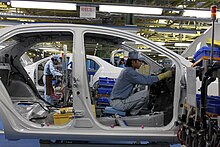
According to the current OICA ranking, Toyota was officially recognized as the largest car manufacturer in the world in 2009. According to OICA , the Toyota Group led in 2009 with 7.23 million units. General Motors was in second place with 6.46 million units, Volkswagen in third place with 6.06 million units. Official OICA rankings for the previous year are published in the summer of the following year. According to the three manufacturers, the trend continued in 2010. Volkswagen remains in third place with 7.1 million units delivered. The GM group is still in second place with 8.38 million units. The Toyota Group is number one with 8.55 million units produced. Hyundai-Kia moved up to fourth place.
In the first quarter of 2011, shifts became clear. According to the manufacturer, GM was in first place with 2.085 million units, Volkswagen was in second place with 1.99 million units. Toyota moved up to third place with 1.72 million units.
Toyota had to contend with further declines in production caused by the aftermath of the earthquake and tsunami in Japan . In April 2011, in the month after the disaster, global production at Toyota fell by 48.1%, while production in Japan itself was estimated at 74.5%. The Wirtschaftswoche speculated: "The former industry model may even fall behind Volkswagen and Hyundai / Kia in fourth place".
Series of breakdowns and damage to image 2009–2010
Stuck accelerator
In January 2010, Toyota began a recall of 2.3 million cars in the US and 1.8 million in Europe due to some alleged sticking of the accelerator pedals that would not return to their original positions while driving. This affected the models Auris , Avensis , Aygo , Corolla , iQ , RAV4 , Verso and Yaris from different years of construction. In the United States, the production and sale of these models has been temporarily stopped.
In early February 2010, the US Federal Highway Traffic Safety Administration stated that accidentally accelerating cars had been involved in more than 200 accidents with 34 deaths on US roads.
According to estimates, the group could face expenses of 150 million euros for spare parts alone, and experts forecast several billion US dollars in relation to the expected wave of lawsuits from the relatives of the victims and unsettled customers.
From February 24, 2010, Toyota must answer to the relatives of accident victims in Washington, particularly with regard to the question of how long Toyota knew about the breakdowns. Jamming gas pedals appeared in Europe as early as 2008, after which production was changed in 2009. According to the company, there were no accidents that can be traced back to this phenomenon in Europe.
According to the assumption of Toyota engineers, the reason for the increased occurrence of serious accidents with jammed gas pedals in the USA is the poor driver training in the USA, so the drivers concerned would not turn the automatic selector lever to neutral (N) in the excitement (which would make the engine howl ), but continue to drive in the Drive stage (D). Braking in the D-level leads to a standstill if it happens immediately and not "half-heartedly". In the N position, the vehicle would no longer be driven and would therefore be slower. Overstressing of the brakes would also be avoided.
Braking problems
In February 2010, Toyota was again prompted to carry out a recall. Because of problems with the brakes, the company recalled 437,000 vehicles of the hybrid Prius model worldwide .
According to Toyota, the problem is that on a slippery road at a speed of 3–5 km / h and only light braking, the brake reacts with a delay of one to two tenths of a second, which creates a strange feeling. In the event of an emergency stop, however, the entire brake pressure is available. An update of the ABS control unit corrects the problem.
Investigations
An attempt by Bild am Sonntag on February 14, 2010 showed that two tested vehicles could be brought to a stop without mechanical difficulties despite the accelerator pedal being fully depressed. Owners of the Prius models also speak of “a strange braking feeling” and not of a complete failure of the braking system; this is consistent with the statements made by Toyota.
An analysis of the electronic accident tachographs of 58 vehicles involved in an accident by the US traffic safety authority NHTSA showed that in at least 35 cases no braking was carried out at all, in other cases only half-heartedly or only at the last second.
A study published by NASA in January 2011 came to the conclusion that there were no faults in the electronics, but rather a mechanical problem such that the pedal might have jammed, partly allegedly caused by a doormat. Often, however, the brake and accelerator pedals were confused.
On February 8, 2011, NASA published the investigation report of the NHTSA commissioned investigation of "unwanted accelerations". The report notes that only one of the accidents in the US was due to a sticking accelerator pedal. In no case could an error in the electronics be found. The unwanted accelerations were caused by incorrect operation of the vehicles. In most cases the accelerator was depressed strongly, probably after the accelerator and brake pedals were mixed up. A total of 75 complaints about unintentional acceleration between January 1, 2000 and December 31, 2010 were investigated. It was noticeable that 85% of the incidents only occurred after Toyota had started the recall campaign.
In October 2013 a court in Los Angeles investigated one of the accidents from the series in 2009. In this case, too, no evidence of a technical failure of the vehicle in a fatal collision was found. The American court thus further exonerated Toyota. That same month, a US court in Oklahoma found Toyota guilty of another case. Michael Barr, software expert for embedded systems, submitted a study under oath that showed that the vehicle software contained errors that could lead to unintended acceleration. He also pointed out that the NASA investigation report came under tight deadlines and that some important facts were not known to NASA. Toyota had to pay $ 3 million in damages and settled the lawsuit by reaching an out-of-court settlement with plaintiffs.
Consequences from the breakdown series
As a consequence of the series of breakdowns, quality management at Toyota was restructured. Regional competence centers have been established which can react faster to possible problems with the vehicles and to customer feedback via shorter official channels. Furthermore, recalls are used consistently for quality assurance. A recall by an official body (in Germany by the Federal Motor Transport Authority ) ensures that customers outside the manufacturer's guarantee can also benefit from quality improvements. This has led to an increase in product recalls by Toyota in recent years. The notification of customers about these quality assurance measures by the Federal Motor Transport Authority is informative, i. H. the customer does not have to fear any consequences if he does not respond to the callback.
One example of these measures is the recall due to stiff window regulators: In October 2012 Toyota called 7.4 million vehicles into the workshops. The switch for the electric window regulator was not sufficiently lubricated at the supplier. As a result, the window regulator could become stiff over time. This affected vehicles from all over the world. In the USA, some customers tried to solve the problem themselves with electrically conductive lubricant ( graphite ). This resulted in thermal deformation of the switch. According to US law, a fire hazard had to be warned. A large part of the German press did this.
In connection with the accelerator pedal issues, Toyota agreed to a $ 1.2 billion fine in March 2014.
distribution
Sales of vehicles in Germany
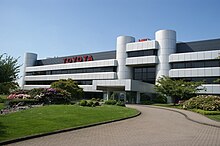
The first Toyota officially imported to Germany was a Corolla 1211 Coupé , which was sold on February 18, 1971. The first importer in Germany was a team of almost ten people in a rented 70 square meter car dealership in Cologne . By 1968 they had imported British brands such as MG and Morris for Woodhouse .
On October 9, 1970, the company “German Toyota Sales Limited Liability Company” was founded. Occasionally, however, vehicles were already registered in Germany before 1970; these came from Belgium (since 1963). In the first official sales year (1971), 883 Corolla and Carina vehicles were registered for road traffic in Germany.
Toyota carefully prepared the vehicles because of the significantly higher speeds on German roads. It took until March 1971 for the first vehicles to be delivered to Germany. The main selling points were the simple design with a rigid axle and leaf springs at the rear as well as the very extensive standard equipment for the time. A few months after the start of sales, the company headquarters was relocated to Frechen-Königsdorf to expand . At the end of 1972, 83 employees were already working there for 332 dealers.
In November 1974 "Toyota Motor Sales Ltd" took over the shares in the Cologne company with 133 employees and 500 dealers. Mitsuo Yamada was at their head. In 1976 the name was changed to "Toyota Deutschland GmbH".
Toyota Deutschland GmbH employs around 350 people in its sales center in Cologne-Marsdorf , where the car manufacturer has presented around 70 vehicles from its model history as the “Toyota Collection” since 2017. Toyota is also represented in Cologne by the companies TLSDE, Toyota Financial Services (TFS), Toyota Informations-Systeme GmbH (TIS), Toyota Kreditbank (TKG) and Toyota Motorsport GmbH. Toyota has a total of around 1500 employees in Cologne. On August 22, 2002, the two millionth vehicle was handed over to a customer. The market share of the automobile brand Toyota was 3.93% in 2005 and around 2.4% in 2018.
Dealer network structure in Japan
In Japan, the Toyota brand vehicles are sold through different dealerships (sales channels). A model is assigned to one or two of these retail brands. On Toyota's Japanese homepage, you can immediately see which type of dealer can be found for each model.
There are currently the following four retail brands or sales channels:
Lexus models are sold separately from Toyota.
Sales designations (Central Europe)
| construction time | model series | annotation | image |
|---|---|---|---|
| Microcar | |||
| since 2005 | Toyota Aygo | The Aygo emerged from the cooperation with PSA and is therefore identical to the Citroën C1 as well as the Peugeot 107 and 108 . |

|
| 2009-2014 | Toyota iQ | Positioned as a competitor to the Smart Fortwo . |

|
| Small car | |||
| 1961-1978 | Toyota Publica | The small car Publica was offered as the Toyota 1000 in Europe as a sedan and station wagon from 1971 to 1978 . |
|
| 1978-1999 | Toyota Starlet | The Starlet replaced the 1000 as a hatchback and station wagon in Europe in 1978 . From 1984 the Starlet had front-wheel drive and was only available as a three- or five-door hatchback model. |

|
| since 1999 | Toyota Yaris | A small car that has replaced the Starlet since spring 1999. In Japan the model is called Vitz , which is also sold there as a notchback version Belta . |

|
| Compact class | |||
| since 1966 | Toyota Corolla | Best-selling car in the world and successful compact car from Toyota, which was also offered in Europe from spring 1971 to early 2007. The Corolla has been available again in Germany since 2013, but only as a notchback. It was included in the program without advertising. In 2019, other body variants such as notchback, hatchback and station wagon will come onto the German market. Various hybrid variants are also available. |

|
| 1978-1999 | Toyota Tercel | The Tercel is a compact class car that was also partly offered in Europe until 1992. Body styles: notchback, hatchback and station wagon. |
|
| 2007-2019 | Toyota Auris | Since the beginning of 2007, the Auris has replaced the Corolla in Europe. In parallel with the Auris, a better equipped version is offered as a Blade in Japan . After the revision in spring 2010, a hybrid version was also added to the range. The second generation of the Auris followed at the end of 2012, and has also been built as a station wagon for the first time since mid-2013. |

|
| Middle class | |||
| since 1957 | Toyota Corona | In Europe, the Corona was offered as Toyota's contribution to the upper middle class between 1971 and 1977 and was later replaced by the Cressida . Carina and Avensis have been largely based on the Corona floor pan since 1970 . |

|
| 1970-2001 | Toyota Carina | Initially introduced as a cheaper version of the Corona , it took over the role of Toyota's mid-range model in export from 1977. In early 1998 it was replaced by the Avensis in Europe . |
|
| 1998-2018 | Toyota Avensis | Like the Carina in the past, largely identical to the Corona model, which is reserved for the Asian market . The third generation has been available since the beginning of 2009. |

|
| since 1997 | Toyota Prius | The Prius is the first large-scale hybrid model. The fourth generation has been on the market since the beginning of 2016. |
|
| since 2014 | Toyota Mirai | Similar to the Prius, the Mirai is also a pioneer of its kind, as it is the first series fuel cell vehicle in larger numbers . It has been available in Japan since December 2014, and in Germany since September 2015. The second generation was announced for 2020. |
|
| upper middle class | |||
| 1967-2004 | Toyota Mark II | This vehicle was also offered in Europe as the Toyota Corona Mark II from 1973 , but was replaced by the Cressida in 1977 . |

|
| 1973-1993 | Toyota Cressida | Toyota's contribution to the upper middle class in the European markets between 1977 and 1985. There it was considered the successor to the Toyota Corona / Mark II . |

|
| since 1980 | Toyota Camry | The Camry was first offered in Europe as a notchback and hatchback sedan from the beginning of 1983. As an independent model, it replaced the Cressida in Europe as a sedan and station wagon in autumn 1986, where it was sold until mid-2004. In 2019, the series was introduced again in Europe as the successor to the Avensis. In Japan and the USA it was also available as a coupé and convertible from 1998 to 2008 ( Camry Solara ). In the United States, the Camry is one of the best-selling cars. From 2001 to 2017, the Asian model was visually different from the international version. The current generation is uniform again. |

|
| Coupes | |||
| 1991-1999 | Toyota Paseo | The first Paseo generation (L4) was only offered on the North American and Japanese markets, while the second generation (L5) also came to Europe from 1996. This version was also available as a convertible. |

|
| 1970-2005 | Toyota Celica | The Celica was a sporty coupé based on the Corona / Carina. The model was produced in seven generations from autumn 1970 to summer 2005. In the USA it was replaced by the Scion tC . |

|
| since 2012 | Toyota GT86 | After seven years of abstinence, Toyota has again had a sports coupé in its range with the GT 86 since summer 2012. It shares the technical basis with the Subaru BRZ and Scion FR-S models (until 2016). |
|
| Sports cars & roadsters | |||
| 1967-1970 | Toyota 2000 GT | The model was presented at the Tokyo Motor Show in 1965. The model is sold at very high prices by today's automobile collectors, as only 351 units of the vehicle were produced. |

|
| 1984-2007 | Toyota MR2 | The MR2 presented at the end of 1984 was a mid-engined coupé that was also available with removable roof parts (Targa). From the beginning of 2000 it became a roadster with a vinyl top. In Japan it was sold as the Toyota MR-S from then on . |

|
| 1986-2002 | Toyota Supra | Between 1978 and 1986 the Supra was a sport version of the Celica, but after that it was built as an independent model until 2002. |

|
| since 2019 | Toyota GR Supra | Since 2019 Toyota has been offering a sports car again with the GR Supra. He shares the platform with the BMW Z4 . |

|
| Off-road vehicles , SUVs and pick-ups | |||
| since 1950 | Toyota Land Cruiser | Successful off-road vehicle also sold as Toyota Prado in some markets (in Brazil as Toyota Bandeirante ). |

|
| since 1968 | Toyota Hilux | Pickup originally developed by Hino Jidōsha as a smaller, better equipped model of the Toyota Stout . |

|
| since 1984 | Toyota 4Runner | A mid-size off-road vehicle sold in Europe until 2001 and as Toyota Hilux Surf in Asia until 2009 . |

|
| since 1994 | Toyota RAV4 | When it appeared in the summer of 1994, it became the founder of the Softroader (SUV), better known in Germany as the "Funcruiser". The fourth generation will follow in spring 2013. |

|
| since 2001 | Toyota Highlander | Initially only available in Japan, China and North America. In other words, the Otto-Hybrid is to be sold in Europe from 2021 on, the almost five meter long vehicle |

|
| 2009-2014 | Toyota Urban Cruiser | The Urban Cruiser was presented as a concept vehicle at the 2008 Paris Motor Show. Since the beginning of 2009 it has also been available as a series model with all-wheel drive. |

|
| since 2016 | Toyota C-HR | The Toyota C-HR is a crossover SUV that was presented for the first time in 2014 in Paris at the Mondial de l'Automobile as the Toyota C-HR Concept design study. |

|
| from 2020 | Toyota Yaris Cross | The Yaris Cross was presented in spring 2020 based on the Yaris. It is positioned below the C-HR. | |
| Vans | |||
| since 1978 | Toyota TownAce | The TownAce was offered as the Model F / Spacecruiser in Europe from 1982 to 1992 , as the Toyota Van from 1982 to 1990 in North America and as the Toyota Tarago in Australia . The Toyota Liteace served as the basis . |

|
| since 1990 | Toyota Estima | In Australia Toyota Tarago . Offered as Toyota Previa until 1997 in North America and until 2005 in Europe . |

|
| 1996-2001 | Toyota Picnic | A compact van based on the Carina and alternatively called the Toyota Ipsum . Its successor was the Toyota Avensis Verso . |

|
| 1999-2005 | Toyota Yaris Verso | Minivan based on the Yaris / Vitz . |

|
| 1997-2009 | Toyota Corolla Spacio | Available in Europe from 2001 to 2009 as Corolla Verso , although it was built for Europe after the facelift in the spring of 2004 in Toyota’s Turkish plant. |

|
| 2001-2009 | Toyota Avensis Verso | A van based on the Avensis. It received an optical redesign in 2004, but sales in Germany were discontinued in mid-2005. Until 2009, can only be ordered abroad. Alternatively (like its predecessor Picnic) called Toyota Ipsum . |

|
| 2009-2018 | Toyota Verso | The Verso replaced the Corolla Spacio / Verso and Avensis Verso in the model range . The facelift has been delivered since April 2013. |

|
| 2011-2015 | Toyota Verso-S | Small van below the Toyota Verso as a competitor to the Opel Meriva . In Japan as Toyota Ractis . |

|
| since 2011 | Toyota Prius + | The van version of the Prius . Called “Prius V” in the USA, the “V” standing for “Versatility”. |

|
| since 2020 | Toyota Proace City | Up to seven-seater van based on the Citroën Berlingo . |

|
| Transporter and delivery truck | |||
| since 1959 | Toyota Dyna | Partially marketed as Toyoace in Japan , also offered in Europe since 1977. Until 2003 also built as Daihatsu Delta and since 2000 also as Hino Dutro . |

|
| since 1967 | Toyota Hiace | The Toyota Hiace is a panel van and minibus that is also built as the Toyota Commuter minibus . There was also a pickup truck in the first generations. |

|
| since 1970 | Toyota LiteAce | It is built in different body styles: panel vans, station wagons, minibuses and pickups. Also offered in Europe until 1996. |

|
| 1995-2011 | Toyota Hiace Europe | From 1995 to 2011 Europe had its own Hiace model based on the Toyota Granvia . In Asia it was offered as Grand Hiace until 2005. |

|
| since 2013 | Toyota Proace | The Proace has been available in Europe as a delivery van since 2013, which is produced by PSA Peugeot Citroën using badge engineering and shares the technical basis with the Peugeot Expert and the Citroën Jumpy . The second generation was presented at the Geneva Motor Show in 2016 and then also built as a small van. |

|
| Models not sold in Central Europe | |||
| 1954-1986 | Toyota Stout | Toyota's first pickup truck, originally called the Toyopet Stout. Export also to North America . |

|
| 1965-1969 | Toyota Sports 800 | Toyota's first mass-produced sports car. |

|
| 1967-1970 | Toyota 2000 GT | Sports cars sold in small numbers. |

|
| 1980-1990 | Toyota Blizzard | Off-road vehicle based on the Daihatsu Taft and Daihatsu Rugger . |

|
| 1982-2003 | Toyota Vista | Japan only; until 1998 version of the Toyota Camry ; Basis for the first Lexus ES 250 (1989–2001). The combination version was called Ardeo. |

|
| 1983-1987 | Toyota Sprinter Trueno | Similar to the Toyota Corolla. |

|
| 1983-2005 | Toyota Soarer | The Lexus SC was sold as the Toyota Soarer in Japan. The Lexus brand is now also used there. |
|
| 1985-1989 | Toyota Corona Coupe | Sporty coupé, sister model of the Celica . |

|
| 1990-1995 | Toyota Sera | Right-hand drive model only. |

|
| 1991-1993 | Toyota Lexcen | Available in Australia only; it was a contemporary Holden Commodore with Toyota emblems. |
|
| 1991-1999 | Toyota Cynos | No distribution in Germany. Almost identical to the Paseo. |

|
| 1991-2006 | Toyota Windom | Model offered in Japan based on the Toyota Camry , which has now also been replaced there by the Lexus ES . |
|
| 1992-2007 | Toyota Caldina | Distribution in Japan only. |
|
| 1993-2005 | Toyota Aristo | The Lexus GS was sold in Japan as the Toyota Aristo. The Lexus brand is now also used there. |

|
| 1994-1998 | Toyota Curren | Sports coupe; was offered on various markets. |
|
| 1995-2005 | Toyota Granvia | Minivan that also provided the base for the Hiace Europa. |

|
| 1995-2002 | Toyota Mega Cruiser | Off-road vehicle, only in Japan. |

|
| 1996-2000 | Toyota Cavalier | As a mid-range sedan, the Japanese sister model of the Chevrolet Cavalier should delight the masses. But the model became a slow seller and flopped. He was eventually succeeded by the far more successful Allion . |

|
| 1997-2002 | Toyota Regius | Four wheel drive van based on the Granvia. |

|
| 1997-2004 | Toyota Kijang | Only in Asia and South Africa. AUV (Asian Utility Vehicle), available as a pick-up and minibus. Originally a replica of the Toyota Hilux, it was built by Toyota Indonesia. Also sold as Toyota Tamaraw in the Philippines between 1998 and 2004 . Variants of the minibus are FX (rear doors) and Revo (tailgate). |

|
| 1998-2006 | Toyota Celsior | The Lexus LS was sold in Japan as the Toyota Celsior. Meanwhile, the Lexus brand has also been introduced there. |

|
| 1998-2004 | Toyota Duet | No distribution in Germany. Identical to the Daihatsu Sirion . |

|
| 1998-2004 | Toyota Gaia | A van that competed against Nissan Prairie and Honda Shuttle . Was replaced by the Toyota Isis. |

|
| 1998-2006 | Toyota Altezza | In Europe and the USA as Lexus IS . Meanwhile, the Lexus brand is also used in Japan. |

|
| 1998-2007 | Toyota Progrès | A mid-size sedan that was only sold in Japan. |

|
| 1998-2009 | Toyota Camry Solara | Coupe and convertible versions of the Camry sold in the US only. | |
| 1999-2005 | Toyota Cami | With its sporty design, the Cami was aimed at young customers. The Cami is a sister model of the Daihatsu Terios. |

|
| 1999-2006 | Dario Terios | Small SUV for the People's Republic of China. Was also built and sold in Japan for a short time. The model was only sold under the model name. |

|
| 2000-2005 | Toyota Echo | Notchback version of the Yaris / Vitz, sold exclusively in North America, identical to the Toyota Platz . |

|
| 2000-2005 | Toyota Origin | Upper-class sedan in retro style, only right-hand drive. |

|
| 2000-2005 | Toyota Grandpa | The seven-seater compact van was introduced exclusively to the Japanese market in October 2000. |

|
| 2002-2004 | Toyota Voltz | Japan version of the Pontiac Vibe. |

|
| 2002-2007 | Toyota is | Japan only; sold in the US as Scion xA . |

|
| since 1953 | Toyota Crown | Wide range of models, currently available in Japan as Crown Athlete , Crown Hybrid , Crown Majesta and Crown Royal . |

|
| since 1959 | Toyota Coaster | The Toyota Coaster is a minibus manufactured by Toyota in Japan. |

|
| since 1967 | Toyota Century | Luxury sedan; Sales in Japan and some Asian countries. |
|
| since 1982 | Toyota Commuter | Minibus based on the Hiace . |

|
| 1995-2017 | Toyota Comfort | Competing model for the Nissan Crew , only in Japan. Still offered as a popular taxi model. |
|
| since 1995 | Toyota Avalon | For USA / Asia only. The last model change was in 2012. |

|
| since 1995 | Toyota Tacoma | Pickup with three different cabins. |

|
| since 1997 | Toyota Harrier | The Lexus RX was sold as the Toyota Harrier in Japan and Singapore. The current generation is no longer based on the RX, but on the MC platform, making it a brother of the Toyota RAV4. |

|
| 1997-2011 | Toyota space | Compact van; only in Japan. |

|
| since 1998 | Toyota Tundra | Large pick-up with a six or eight cylinder engine. |

|
| since 1998 | Toyota Sienna | Spacious family van with sliding doors. From February 2010 in a new design. |

|
| 2000-2016 | Toyota bB | Japan only; First generation offered in the USA as Scion xB , in Germany identical to Daihatsu Materia. |

|
| since 2000 | Toyota Kluger | For Japan (1st generation only) and Australia, identical to the Toyota Highlander and since 2006 with the Toyota Vanguard . |

|
| since 2001 | Toyota Sequoia | Only in the US and the Arabian Peninsula. |

|
| since 2001 | Toyota Voxy | Technically identical eight-seater to the Noah. |

|
| since 2001 | Toyota Allion | Lower middle class notchback sedan offered only in Japan, successor to Toyota Carina ; Sister of the Toyota Premio with a more pronounced sideline. |

|
| 2001-2007 | Toyota Brevis | Japan only; with minor differences also offered as Toyota Progrès . |

|
| since 2001 | Toyota Noah | Van, only in Japan; also called Toyota Voxy . |
|
| since 2001 | Toyota Premio | The sedan has an optional all-wheel drive. |

|
| 2002-2014 | Toyota Matrix | Cooperation with Pontiac (Pontiac Vibe) for North America; no distribution in Germany. |

|
| since 2002 | Toyota Probox | Family vehicle with lots of space. |

|
| since 2002 | Toyota Alphard | Only in Japan and Southeast Asia (Indonesia). Available as a hybrid version since 2011. |

|
| since 2002 | Toyota Succeed | Van; only in Japan; the delivery van variant is sold as Toyota Probox . |

|
| since 2003 | Toyota Sienta | A minivan. |

|
| since 2003 | Toyota Avanza | High-build compact class van. |

|
| since 2003 | Toyota (Kijang) Innova | Successor to the Toyota Kijang ; was briefly offered in the Philippines as Toyota Revo . |

|
| since 2003 | Toyota Vios | Compact sedan sold only in Southeast Asia and China. |

|
| 2003-2017 | Toyota WISH | Seven-seater van distributed in Asia. |
|
| since 2004 | Toyota Ses'fikile | Passenger transporter for up to 14 people, from South Africa. |
|
| 2004-2017 | Toyota Isis | Van offered in Japan only. |

|
| 2004-2019 | Toyota Mark X | Japan only; in China as a Toyota allure . |

|
| since 2004 | Toyota Porte | Minivan; only in Japan. |

|
| since 2005 | Toyota Passo | Renamed Daihatsu Sirion , also available in Germany as Subaru Justy . |

|
| since 2005 | Toyota Fortuner | All-wheel drive crossover. |

|
| since 2005 | Toyota Ractis | Minivan (successor to Toyota Yaris Verso , also sold in Europe ); available in Japan and Southern Europe. |

|
| since 2005 | Toyota Rush | Japan only; renamed Daihatsu Terios . |

|
| 2006-2016 | Toyota Belta | Notchback sedan based on the Yaris small car . |

|
| since 2006 | Toyota Blade | Mid-range model with four- and six-cylinder engines. Identical to Toyota Auris. |

|
| 2006-2017 | Toyota Aurion | Sedan offered in Australia based on the Toyota Camry . |

|
| since 2006 | Toyota FJ Cruiser | Retro style heavy off-road vehicle, mainly for Japan and North America. |

|
| since 2007 | Toyota Corolla Axio | Notchback version of the Corolla, which is also available as a station wagon (Corolla Fielder). In North America the model is called Corolla and in Southeast Asia Corolla Altis . Since the model change in 2013, this car has only been offered in Asia and New Zealand, which has since been optically different from the normal Corolla. |

|
| 2007-2013 | Toyota Mark X Zio | Variable and elegantly equipped five-seater. |

|
| since 2007 | Toyota Quantum | Vans developed for tour operators by Toyota South Africa. |
|
| 2007-2015 | Toyota Corolla Rumion | Corolla-based minivan; in Asia and Australia as Toyota Rukus . |

|
| since 2007 |
Toyota Ventury Toyota Ventury Majesty |
Vans developed for Toyota Thailand tour operators. |

|
| 2007-2013 | Toyota Vanguard | Contrary to its name, not a van, but an SUV. |

|
| since 2008 | Toyota Vellfire | Van available only as an eight-seater. Available as a hybrid version since 2011. |

|
| 2008-2017 | Toyota Venza | New crossover with van and station wagon variations. |

|
| 2009-2017 | Toyota SAI | Hybrid model, only offered in Japan. Identical to the Lexus HS 250h (offered in the USA and Japan). |
|
| since 2010 | Toyota Etios | A small car for the Indian market, also as a notchback. |

|
| since 2012 | Toyota Prius c | A compact hybrid model with the drive technology of the Yaris Hybrid. It is offered in the USA, Australia and Japan, among others. In Japan the model is called Toyota Aqua . The Prius c is not offered in Germany because the Yaris Hybrid serves as an entry-level hybrid model there. |

|
Studies

- Toyota CS&S
- Toyota Motor Triathlon Race Car
- Toyota RSC
- Toyota Fine N
- Toyota i-unit
- Toyota Auris HSD - Concept study of a full hybrid version of the Toyota Auris especially for the European market
- Toyota Prius PHV ( P lug-in H YBRID V ehicle) - Development of the Toyota Prius full hybrid third generation with 100 km / h and 20 km range in pure electric drive
- Toyota FT-EV - electrical study on the IQ platform, 110 km / h top speed, 80 km range
- Toyota FCHV-adv - Fuel cell hybrid vehicle with a range of 830 km (2008)
- Toyota GR Super Sport Concept - Concept car based on the technical basis of the Le Mans prototype Toyota TS050 Hybrid
- Toyota FCV-Concept 2013 - near-series fuel cell hybrid vehicle
Production sites and sales
Toyota currently produces in 63 plants, but not in Germany, Austria or Switzerland. 12 plants are in Japan, 51 in 26 other countries:
- Argentina, Zárate : Toyota Argentina - founded in 1996, production of the Hilux and since 2006 the Fortuner , here called SW4, for the Mercosur region .
- Australia : Toyota Australia (until 2017)
- Brazil, São Paulo
- PR China, Changchun : Tianjin FAW Toyota Motor Company , car production Toyota Vitz / Echo , Prius
- France, Onnaing near Valenciennes : Toyota Motor Manufacturing France (Yaris)
- United Kingdom, Burnaston ( Derbyshire ): Toyota Motor Manufacturing (UK) . Car production Avensis and Auris, Deeside ( Flintshire ): engines
- Indonesia, PT Toyota Motor Manufacturing Indonesia in Cikampek, West Java : Car production Innova, Avanza, Fortuner and Hilux Vigo 4x2 pick-up
- Japan
-
Toyota city
- Main plant ( 本社 工場 ; 1938–)
- Motomachi plant ( 元町 工場 ; 1959–)
- Kamigō work ( 上 郷 工場 ; 1965–)
- Takaoka plant ( 高 岡 工場 ; 1966–)
- Tsutsumi plant ( 堤 工場 ; 1970–)
- Work Teihō ( 貞 宝 工場 ; 1986–)
- Hirose work ( 広 瀬 工場 ; 1989–)
-
Miyoshi
- Miyoshi plant ( 三好 工場 ; 1968–)
- Myōchi work ( 明知 工場 ; 1973–)
- Shimoyama work ( 下山 工場 ; 1975–)
- Hekinan : Kinuura plant ( 衣 浦 工場 ; 1978–)
- Tahara : Work Tahara ( 衣 浦 工場 ; 1979–)
-
Toyota city
- Canada (in Cambridge, Ontario): Toyota Motor Manufacturing Canada
- Colombia, factory in Cota , Cundinamarca : production of Hino Jidōsha trucks .
- Mexico, Tijuana : Pick-up Toyota Tacoma
- South Africa
- Thailand
- Toyota Motor Thailand Co., Ltd. (1962)
- Headquarters and Toyota Factory (Samrong) in Samut Prakan
- Bangkok Office in Bangkok
- Toyota Assembly Plant (Gateway) and Toyota Assembly Plant (Ban Pho) in Chachoengsao
- Siam Toyota Manufacturing Co., Ltd. (1987) in Chon Buri : Production of engines
- Toyota Leasing Thailand Co., Ltd. (1993) in Bangkok
- Toyota Automobile Technology Co. Ltd. (1998) in Chachoengsao
- Toyota Motor Thailand Co., Ltd. (1962)
- Turkey, Adapazarı : Auris and Corolla Verso
- Czech Republic, Kolín : Toyota Peugeot Citroën Automobile , production of the Toyota Aygo together with the Peugeot 108 and Citroën C1
- USA, car production Toyota Camry
- Venezuela, Cumaná : Toyota De Venezuela CA,
- Poland, Toyota Motor Industries Poland (TMIP): diesel engines in Jelcz-Laskowice , petrol engines and gearboxes in Wałbrzych
- Russia, Toyota Motors Manufacturing Russia (TMMR) in Saint Petersburg : Toyota Camry for the Russian market
The cars are sold in more than 160 countries worldwide.
Other Toyota brands and special technologies
In addition to the Toyota brand, the Toyota Motor Company also owns the premium automotive brand Lexus and the Scion brand , which was specially designed for the North American market for under-25s. The Toyota Group also includes the small car manufacturer Daihatsu and the truck and bus manufacturer Hino Motors .
Since October 2005 there has been a cooperation between Fuji Heavy Industries (FHI) and Toyota. Since April 2008, Toyota has held a minority stake of 16.5% in FHI and thus in the Subaru car brand produced by FHI . Since November 2006, Toyota has also had a 5.9% stake in the manufacturer Isuzu .
| Toyota vehicle brands timeline since 1935 | |||||||||||||||||||||||||||||||||||||||||||||||||||||||||||||||||||||||||||||||
|---|---|---|---|---|---|---|---|---|---|---|---|---|---|---|---|---|---|---|---|---|---|---|---|---|---|---|---|---|---|---|---|---|---|---|---|---|---|---|---|---|---|---|---|---|---|---|---|---|---|---|---|---|---|---|---|---|---|---|---|---|---|---|---|---|---|---|---|---|---|---|---|---|---|---|---|---|---|---|---|
| Manufacturer | 1930s | 1940s | 1950s | 1960s | 1970s | 1980s | 1990s | 2000s | 2010s | Brand name | Main segment / target group | ||||||||||||||||||||||||||||||||||||||||||||||||||||||||||||||||||||
| Toyota Motor Company | Toyota | Car | |||||||||||||||||||||||||||||||||||||||||||||||||||||||||||||||||||||||||||||
| Toyopet | - | ||||||||||||||||||||||||||||||||||||||||||||||||||||||||||||||||||||||||||||||
| Lexus | Premium / Sport | ||||||||||||||||||||||||||||||||||||||||||||||||||||||||||||||||||||||||||||||
| Scion | younger customers | ||||||||||||||||||||||||||||||||||||||||||||||||||||||||||||||||||||||||||||||
| Want | younger customers | ||||||||||||||||||||||||||||||||||||||||||||||||||||||||||||||||||||||||||||||
| Daihatsu | Daihatsu | Kei car | |||||||||||||||||||||||||||||||||||||||||||||||||||||||||||||||||||||||||||||
| Hino Jidōsha | Hino | commercial vehicles | |||||||||||||||||||||||||||||||||||||||||||||||||||||||||||||||||||||||||||||
| Isuzu | GM was involved | Isuzu | Pick up | ||||||||||||||||||||||||||||||||||||||||||||||||||||||||||||||||||||||||||||
| Fuji Heavy Ind. | Subaru | All-wheel drive | |||||||||||||||||||||||||||||||||||||||||||||||||||||||||||||||||||||||||||||
|
|
|||||||||||||||||||||||||||||||||||||||||||||||||||||||||||||||||||||||||||||||
Toyota is the distributor of D-CAT technology and is the market leader in hybrid vehicle technology . At the International Motor Show (IAA) 2009, the Toyota management underlined the advantages of the technologies developed and questioned the competitiveness of electric vehicles before 2020.
Companies belonging to the Toyota Group (selection)
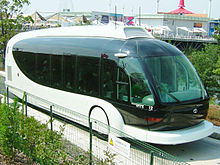
The Toyota Group includes the following companies:
- Toyota Motor Corporation, Ltd. • (founded in August 1937)
- Toyota Motor Sales Corporation, Ltd. • (founded in April 1950, merged with Toyota Motor Corporation in July 1982)
- Toyoda Spinning & Weaving Corporation, Ltd. • (founded in 1918, merged with Toyota Motor Corporation in 1943)
- Toyota Industries Corporation (founded in November 1926 as Toyoda Automatic Loom Works, Ltd. )
- Aichi Steel Works, Ltd. • (founded in March 1940)
- JTEKT Corporation (founded January 1921)
- Toyota Auto Body, Ltd. • (founded in August 1945)
- Toyota Tsusho Co. • formerly: Toyoda Tsusho Kaisha, Ltd. (founded July 1948)
- Aisin Seiki Corporation, Ltd. • (founded in March 1943)
- Denso Co. • formerly: Nippondenso Corporation, Ltd. (founded in December 1949)
- Toyoda Boshoku Corporation • (founded in 1918 as Toyoda Boshoku Corporation, Ltd. , merged with Toyota Motor Corporation in November 1943 , became independent again in May 1950 as Minsei Spinning Corporation, Ltd. , August 1967 renamed Toyoda Boshoku Corporation , merged with Toyota Kako Corporation, Ltd. in October 2000)
- Towa Real Estate Corporation, Ltd. • (founded in August 1953)
- Toyota Central Research and Development Laboratories, Inc. • (founded November 1960)
- Kanto Auto Works, Ltd. • (founded in April 1946)
- Toyoda Gosei Corporation, Ltd. • (founded in July 1949)
- Hino Motors , Ltd. • (founded in October 1966)
- Daihatsu Motor Corporation, Ltd. • (founded in March 1907, cooperation with Toyota since 1967)
In October 2018, Toyota and Softbank announced the formation of Monet Technologies as a joint venture . Toyota Motor Corporation also has interests in Subaru Corporation and KDDI .
Motorsport


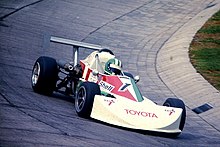
For several decades, Toyota has celebrated major motorsport successes in Formula 3 and rallying . Responsible for this was the Cologne team Toyota Europe (TTE) , which specializes in the tuning of Toyota series vehicles.
At the end of the 1990s Toyota decided to compete in Formula 1 as well. To this end, that was factory team Toyota Racing founded, also from Cologne-Marsdorf worked out. In 2002 the team entered Formula 1, and in 2005 it achieved its best position in the constructors' championship with 4th place. On November 4, 2009, Toyota announced its withdrawal from Formula 1 at the end of the 2009 season. Toyota named the high costs associated with the commitment as the reason.
Since the 2007 season, Toyota has also been the only non-US car manufacturer to compete in the NASCAR series. There is a racing car that is based on the Toyota Camry .
In 2012 Toyota returned to Le Mans (Le Mans 24 Hours ) and also took part in the World Sports Car Championship with its new hybrid petrol LMP1.
The slogan "Nothing is impossible"
“Nothing is impossible” is an advertising slogan for Toyota . The slogan was shown in a television commercial with talking animals, making it one of the most popular advertising slogans. The advertising films increased awareness of the Toyota brand by 176 percent within 14 days. The spots were so popular that the responsible advertising agency received telephone inquiries about the broadcast dates.
"The saying has become so deeply embedded in our consciousness that Bill Clinton , when he was visiting Germany in Berlin and dropped the phrase 'Nothing is impossible', echoed from the audience: 'Tooyooota'."
Considerations to formulate the slogan more positively "Everything is possible ..." were quickly rejected. It stayed with this more concise formula, which is intended to express typical Japanese entrepreneurship and optimism for the future.
Sponsorship
Toyota was the name sponsor of the Toyota Big Air snowboard competition from 1997 to 2014, the name sponsor of the FIFA Club World Cup from 2005 to 2014, and the name sponsor of the Handball Bundesliga from 2007 to 2012 . The company has been the main sponsor of the Kölner Haie since 2002 and the Olympic Games and Team Germany since 2017 . Toyota is also the namesake of the sports facilities Toyota Center in Houston , Toyota Field in San Antonio , Toyota Park in Bridgeview and Toyota Stadium in Frisco .
literature
- Masaharu Shibata, Hideharu Kaneda, Wolfram Mittelhäußer: The best management or management like Toyota - DNA for constant company renewal - The Toyota system. Adept-Media, Bedburg 2015, ISBN 978-3-9807276-6-2 .
- Masaaki Sato: The Toyota Leaders. To an executive guide. Vertical, New York 2008, 336 pages, ISBN 1-934287-23-7 , review:
- Yukiyasu Togo, William Wartman: Nothing Is Impossible - The Toyota Story. Ullstein Verlag, Berlin 1995, ISBN 3-550-06879-4 .
- Helmut Becker: The Toyota phenomenon - ethics as a success factor. Springer Verlag, Berlin 2006, ISBN 3-540-29847-9 .
- Joachim Kuch: Toyota since 1936. Motorbuch-Verlag Pietsch, Stuttgart 2004, ISBN 3-613-02456-X .
- Taiichi Ohno: The Toyota Production System. Campus Verlag, Frankfurt / Main, New York 1993, ISBN 3-593-37801-9 .
- Jeffrey K. Liker: The Toyota Way . McGraw-Hill, New York 2004 ISBN 0-07-139231-9 .
- James P. Womack, Daniel T. Jones and Daniel Roos: The machine that changed the world - based on the Massachusetts Institute of Technology 5 million dollar 5 year study on the future of the automobile. Rawson Verlag 1990, ISBN 0-89256-350-8 .
- James P. Womack, Daniel T. Jones, Daniel Roos: The Second Revolution in the Auto Industry - Consequences of the Worldwide Study by the Massachusetts Institute of Technology. Campus Verlag, Frankfurt am Main 1992, ISBN 3-593-34548-X .
Web links
- Toyota Germany
- Toyota Austria
- Toyota Switzerland
- Toyota Automobile Museum in Japan (English)
- Formula 1 team Toyota (English)
Individual evidence
- ↑ toyota-global.com
- ↑ a b Toyota: Financial Summary 2018. (PDF) Retrieved on August 28, 2018 (English).
- ↑ handelsblatt.com
- ↑ OICA: World Motor Vehicle Production 2016. Retrieved January 14, 2019 (English).
- ^ A b Forbes: Global 2000: The worlds largest public companies. June 6, 2018, accessed January 14, 2019 .
- ↑ Guido Kruschke: The 15 largest automakers worldwide - Toyota in front, Volkswagen new number three. (No longer available online.) In: automobil-produktion.de. Verlag Moderne Industrie GmbH, March 13, 2009, archived from the original on December 8, 2015 ; accessed on November 28, 2015 . Info: The archive link was inserted automatically and has not yet been checked. Please check the original and archive link according to the instructions and then remove this notice.
- ↑ Toyota overthrows General Motors from the throne. Handelsblatt, July 27, 2012, accessed on October 20, 2015 .
- ↑ heise online: Brand ranking list: Apple takes back top position from Google
- ↑ "Head-to-head race: Toyota declares itself to be the world's largest car manufacturer" , Spiegel Online, December 25, 2007.
- ↑ Global Top 100 Companies by Market capitalization. (PDF) PwC, accessed in 2017 .
- ↑ Top 100. The most expensive brands in the world. Der Spiegel, April 21, 2008, accessed November 25, 2012 .
- ↑ Overview Toyota Motor Corporation. Toyota, accessed November 25, 2012 .
- ↑ Why is the car giant Toyota not Toyoda? on bbc.co.uk , February 24, 2010.
- ↑ Cabin scooter from Japan. In: Automotive Technology. 10/1958, p. 394.
- ↑ US car market - Toyota overtakes Ford. In: Süddeutsche Zeitung January 4, 2008 ( Memento from May 8, 2008 in the Internet Archive )
- ↑ Last living Toyota co-founder Eiji Toyoda died of heart failure on September 26, 2013
- ↑ ADAC Motorwelt 5/2008 (breakdown statistics) and 11/2008 (customer satisfaction survey)
- ^ "Germans consider Toyota the most environmentally friendly car brand" on Financial Times Deutschland ( Memento from December 10, 2007 in the Internet Archive ), September 9, 2007
- ↑ a b Toyota now has a worse image than Renault on welt.de , February 6, 2010
- ↑ WORLD MOTOR VEHICLE PRODUCTION - WORLD RANKING OF MANUFACTURERS 2009 (PDF; 17 kB) OICA. Summer 2010. Retrieved May 28, 2011.
- ^ The Truth About Cars Announces The Top Ten Automakers Of 2010 . Thetruthaboutcars.com. January 29, 2011. Retrieved May 29, 2011.
- ↑ General Motors Company and Subsidiaries Supplemental Material ( MS Word ; 226 kB) General Motors. May 11, 2011. Retrieved May 30, 2011.
- ↑ Volkswagen starts fiscal year 2011 with record results in the first quarter. (No longer available online.) In: volkswagenag.com. Volkswagen AG, April 27, 2011, archived from the original on December 8, 2015 ; accessed on November 28, 2015 . Info: The archive link was inserted automatically and has not yet been checked. Please check the original and archive link according to the instructions and then remove this notice.
- ↑ Supplemental Material for Financial Results for FY2011 (Consolidated) (PDF; 137 kB) Toyota. May 11, 2011. Retrieved May 30, 2011.
- ^ Post-Tsunami Trauma: Japanese Car Industry Loses More Than 600,000 Units In April . Thetruthaboutcars.com. May 27, 2011. Retrieved May 29, 2011.
- ↑ TMC Announces Results for April 2011 . Retrieved January 14, 2011.
- ↑ The former industry model may even fall behind Volkswagen and Hyundai / Kia to fourth place. . Retrieved June 12, 2011.
- ↑ a b c d New data - 34 dead in the USA due to Toyota breakdowns. In: tagesschau.de. Norddeutscher Rundfunk, February 16, 2010, archived from the original on February 19, 2010 ; accessed on November 28, 2015 .
- ↑ Current information on the recall campaign for accelerator pedals on Toyota models. Toyota Deutschland GmbH, January 29, 2010, archived from the original on February 1, 2010 ; accessed on November 28, 2015 .
- ^ ADAC: Toyota drivers can stay calm ADAC press service, February 1, 2010.
- ↑ Smoking brakes . In: Der Spiegel . No. 11 , 2010, p. 113 ( online - March 15, 2010 ).
- ↑ Toyota recalls 4000 Prius in Germany on Welt Online , February 10, 2010.
- ↑ Software update optimizes the braking feel. Toyota Deutschland GmbH, February 9, 2010, archived from the original on February 15, 2010 ; accessed on November 28, 2015 .
- ↑ Here BamS slows down the fear from Bild on Sunday, February 14, 2010.
- ^ Another hit for Toyota Tagesspiegel from February 10, 2010.
- ↑ Tachograph evaluation relieves Toyota on Spiegel online , August 11, 2010.
- ↑ Albrecht Ziegler: NASA study partially relieves Toyota - it was the mechanics, not the electronics. In: tagesschau.de. Norddeutscher Rundfunk, February 9, 2011, archived from the original on April 18, 2014 ; accessed on November 28, 2015 .
- ↑ Fight for the gas pedal: Nasa, Toyota - and an evil mat on sueddeutsche.de , February 9, 2011.
- ^ Accident series: NASA study relieves Toyota , SPON , February 8, 2011.
- ↑ NASA's Toyota Study Released by Dept. of Transportation NASA, February 8, 2011.
- ↑ Expensive satisfaction: NASA report exonerates Toyota Heise Auto, February 9, 2011.
- ↑ Dispute over accelerator pedals: US court sees no accident guilt at Toyota Heise Auto, October 11, 2013
- ↑ US court: Motor electronics from Toyota to blame for accident Heise, October 31, 2013
- ↑ Michael Barr: Bookout V. Toyota - 2005 Camry L4 Software Analysis. (PDF; 15 MB) 2013, archived from the original on February 28, 2014 ; accessed on November 28, 2015 (English).
- ↑ Toyota initiates personnel changes and leaner structures Springer, March 10, 2011
- ↑ Toyota: Every recall helps to improve our production system ( memento of the original from October 21, 2013 in the Internet Archive ) Info: The archive link was automatically inserted and not yet checked. Please check the original and archive link according to the instructions and then remove this notice. Produktion.de, November 6, 2012
- ↑ Toyota recalls millions of cars Handelsblatt, October 10, 2012
- ↑ Risk of fire from electric windows: Toyota recalls seven million cars worldwide rp-online.de, October 10, 2012
- ^ Accelerator malfunction: Toyota has to pay billions in fine in the US , Spiegel Online, March 19, 2014
- ^ Toyota Deutschland GmbH in Marsdorf. In: KuLaDig, Kultur.Landschaft.Digital. Retrieved March 30, 2020 .
- ↑ Kraftfahrt-Bundesamt - 2019 - press release No. 01/2019 - vehicle registrations in December 2018 - annual balance sheet. Retrieved February 24, 2019 .
- ↑ Toyota's Global Strategy (PDF), English, page 12
- ↑ toyota.jp Overview of the dealer brands and the models sold through them Japanese
- ↑ Toyota's first fuel cell vehicle on the market this summer. November 17, 2014, accessed October 6, 2019 .
- ↑ t3n.de of September 29, 2019, fuel cell: New generation of the Toyota Mirai is coming in 2020 , accessed on October 6, 2019
- ↑ PSA / Toyota van Geneva 2016 , autobild.de December 1, 2015
- ↑ autobild.de of June 23, 2008, everyday hybrid , accessed on October 6, 2019.
- ↑ welt.de of November 5, 2013, Hydrogen March - Toyota FCV Concept , accessed on October 6, 2019.
- ^ Siam Toyota Manufacturing - The global No. 1 of engine manufacturing Company ( en ) Retrieved November 25, 2012.
- ↑ Japan's Fuji Heavy shares rally on expanded alliance with Toyota group on forbes.com ( Memento from February 17, 2009 in the Internet Archive ), April 11, 2008 (English)
- ↑ "Toyota continues to rely on hybrid drives" on boersennews.de , September 15, 2009
- ↑ Toyota and SoftBank Agreed on Strategic Partnership To Establish Joint Venture for New Mobility Services In: toyota.co.jp, October 4, 2018, accessed October 5, 2018.
- ↑ Toyota to Withdraw From F1. In: USA Newsroom. Toyota Motor Sales, USA, Inc., November 4, 2009, accessed November 28, 2015 .
- ↑ Toyota Motor Corporation returns to Le Mans , ACO website (English)
- ↑ Starter list Sports Car World Championship 2012 ( page no longer available , search in web archives ) Info: The link was automatically marked as defective. Please check the link according to the instructions and then remove this notice. , Sportscar-info.de
- ↑ a b Wikipedia: List of winged words / N
- ↑ Michael Schwelien: Please (a little) guidance! In: Die Zeit 29/1994. July 15, 1994, archived from the original on June 18, 2013 ; accessed on August 19, 2019 .
- ↑ Book review: Masaaki Sato analyzes Toyota's success story up close In: manager Magazin No. 2, 2009

